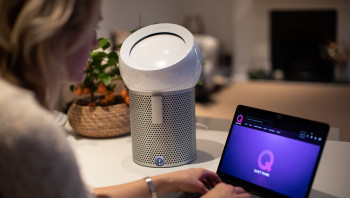Getting Your Kids to Turn It Down a Notch (or Several)


Getting Your Kids to Turn It Down a Notch (or Several)
By JILL WALBIESER for THE NEW YORK TIMES
Image: SOPHIA FOSTER-DIMINO
A mother raising a deaf son paradoxically lives in a house full of noise. But she learns from him how to unplug and disconnect.
In my house, mornings begin with a bang. Usually, from a door being thrown open, followed by the belligerent bellow, “Ma! Milk!” that sounds more like it came from a pro wrestler than the pajama-clad 6-year-old crashing into my bedroom. It’s 6 a.m. (if I’m lucky) and my eyes are still shut, but my ears are wide open.
My son starts every day at top volume, and doesn’t let up a decibel. After his initial wake-up call, there’s giggling, shrieking, the pounding of feet on the stairs. The auditory onslaught continues throughout the morning, and runs the gamut from long periods of nonsensical chanting (“pup-py DOG, pup-py DOG!”) to screeching his own video game sound effects. And the volume only seems to increase when I put his cochlear implants on and he can hear himself.
Of all the ways in which I was unprepared to raise a deaf child, dealing with a constant, sustained level of noise has been the least expected. And it has only grown more constant, and more noisy, since the pandemic began.
“Audiologists have known for a long time that classrooms can be noisy environments,” said Lisa Vaughan, Au.D., who specializes in children’s hearing at Cook Children’s Medical Center in Fort Worth, Texas and is a past president of the American Academy of Audiology. “But the average home isn’t much better.”
Dr. Vaughan, a mother of two, is familiar with the usual sounds of having kids at home: the television or tablet on in the background, the low drone of the dishwasher, a dog barking, occasional unexplained crashes and clatters. All these things, she said, range from 60 to 90 decibels, and sound even louder if they’re occurring at the same time. Normal speech is around 50 to 60 decibels and a baby’s cries can get up to around 110 decibels. My son usually lands in the 70 decibels range, around the same as your average vacuum cleaner.
This kind of volume is aggravating for sure, but it’s only one component of what we call noise. What makes a sound soothing or grating depends on many factors that researchers are still teasing out, as well as personal preference (ocean sounds to you may be lovely, but make me want to run to the restroom). At its most basic, noise is any unwanted sound, experts say, whether the noise is a neighbor’s leafblower or a stereo playing Bach.
While excessive noise poses a certain risk to hearing, the more immediate problem is that it can stress us out, mentally and physiologically. But because it’s invisible — and because parents are already freaking out about so much else right now — it’s often an overlooked source of stress.
“We are hard-wired to respond to certain sounds in our environment as alerts,” said Lynn Bielski, Ph.D., an assistant professor of audiology at Ball State University. Although sound is mostly processed in the brain’s auditory cortex, unpleasant noises also activate the amygdala, which processes emotions like anxiety and aggression. That activity can provoke the hypothalamus to make physical changes — faster heart rate and higher blood pressure — that we may not even notice in the moment.
But chronic exposure to noisy environments — living near high-traffic areas, for example — can increase the risk for high blood pressure or a stroke and it can contribute to anxiety, depression, lower quality sleep and lower concentration. Dr. Bielski recounted a classic experiment in which adults performed a simple memorization task. When the experiment was repeated with background noise, recall went down significantly. Today, parents are attempting much more difficult tasks, like high-level conversations with other adults, in much more auditorily chaotic environments.
Also, kids’ sounds aren’t like other background noises. One determinant of how irritating a sound is, Dr. Bielski said, is how much you need to pay attention to it. So the routine hum of the air conditioning unit can easily fade into the background, but the crashes coming from a dining room don’t.
“Noise is more than just volume,” said Poppy Szkiler, the founder and chief executive officer of Quiet Mark, a business based in London that helps companies design quieter products through intelligent design. “In most homes, the beeps and bleeps and alerts and microwave pings are much more than our brains were ever meant to cope with.”
Sound is, after all, a form of energy. You absorb more sound waves in enclosed spaces than outdoors. So being stuck in a noisy home can make the endless din seem inescapable. It isn’t.
Szkiler recommends what she calls a “noise audit,” which involves doing what we always tell our kids to do: listen.
Tune into all the noise that usually recedes to the background. Is there a TV, tablet or music constantly playing? Turn it off or at least down. Take the batteries out of toys with sirens or loud sounds (each year, the Sight & Hearing Association puts out a list of the noisiest toys). Even the squeakers in pet toys can be surprisingly loud, Dr. Vaughan said, between 110 and 135 decibels depending on how close they are to your ear. Headphones or Bluetooth-enabled devices are perfectly fine for kids, provided they keep the volume to 85 decibels or below and take breaks. Most electronics have settings that allow you to limit their maximum volume.
When eliminating noise isn’t possible, replace harsh sounds, like buzzy alarms, with pleasant ones, like light rainfall. If, as one social experiment found, playing classical music during rush hour reduced acts of vandalism in London subway stations, then maybe it could have a similar effect on calming your rowdy toddlers (or teenagers). Most modern spaces aren’t designed with acoustics in mind, and open floor plans and hard surfaces tend to amplify noise. Fabric, pillows, throw rugs, and even greenery can dampen the din.
“Plants, especially mosses, are one of the most sound-absorbing materials around,” Szkiler said.
And while rumpus rooms may be luxury for most, scheduling “noisy time” can also help. Planning times that kids can be loud, if they choose, can give them a sense of routine, said Jennifer Taitz, PsyD, a clinical psychologist in Los Angeles and assistant clinical professor at University of California, Los Angeles. Even school has recess. “Kids miss socializing and want contact,” Dr. Taitz said. “When kids are screaming, they’re usually saying, ‘Pay attention to me.’”
Responding to them may actually be the key to ending the constant stream of chatter and noise. “As parents, we often inadvertently reward loudness,” she said. If your kid asks for chocolate milk once and doesn’t get a response, she’ll ask again, louder. “If you give in at that point, you’re reinforcing that behavior.” Instead, reward and praise normal-volume speech.
Because my son tends to be visual, I’ve begun using an app that records and displays decibel levels as you speak. He can see where his volume should be and where it actually is. The fact that it’s like a video game — one with thankfully no sound effects — can make being quieter fun for both of us.
Quiet doesn’t have to mean boring. That’s important if you want your kids to keep the noise level down. Build associations between fun and silence by doing a preferred activity like drawing, painting or reading. “To have that down time is healing for everyone,” Dr. Vaughan said. “It helps your body relax and find some peace in this chaotic time.”
Experts say there is no daily quota for silence, but taking frequent breaks from noise is a good idea for toddlers, teens and especially for parents. Use noise-canceling headphones, or go for a walk.
“I have found that the more silence I have, the more I want,” Szkiler said. “It’s nourishing. Silence allows your body to relax its nervous system and take a break from fighting the constant sonic assault.”
As a hearing person, it’s easy to overlook the mental toll noise can take because we can never turn our ears off. But my son can, and does (and not only during my latest lecture about why we don’t ride the dog). When he wants an auditory break, he simply reaches up to the sides of his head and pulls off the magnets that allow his cochlear processors to transmit sound to his auditory nerve.
My brain, however, is forced to keep humming along, processing sound input even while I sleep. That — and being woken by dinosaur roars at 6 a.m. — is a price I’m willing to pay for the beautiful cacophony of living with my son, but I’m learning, from his example, that taking time to unplug, disconnect and enjoy the silence in my head can be just as valuable.
Read the original article on The New York Times website HERE.











 Quiet Mark Founder
Quiet Mark Founder